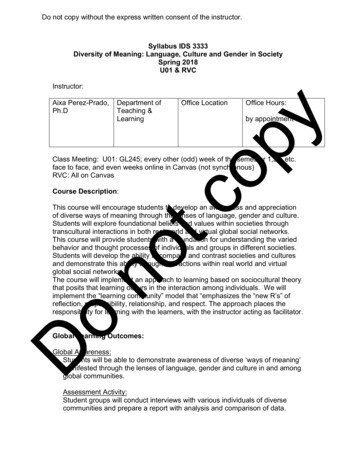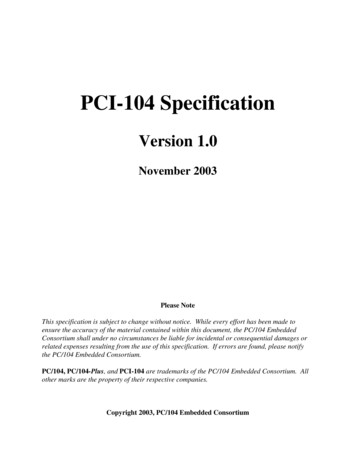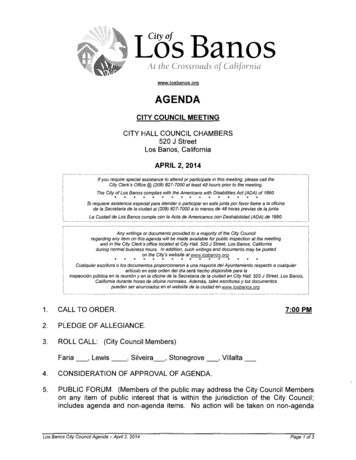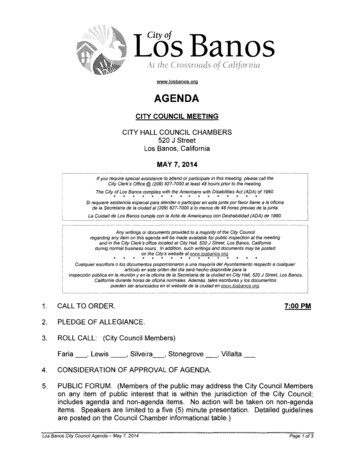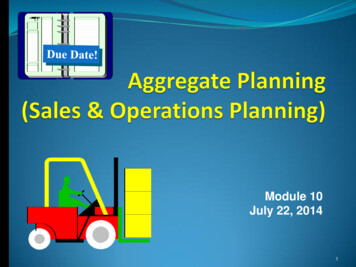
Transcription
15Module 10July 22, 20141
Production Planning ProcessProcess PlanningLongRangeMediumRangeShortRangeStrategic Capacity PlanningAggregate PlanningHow much & whento produce
Aggregate Production Planning/Sales and Operations Planning (S&OP) A managerial statement of timephased–production rates,–work-force levels, and–inventory investment,which takes into account customerrequirements and capacity limitations
Aggregate Production PlanningSales and Operations Planning (S&OP) Objective:Generally to determine the quantity andtiming of production for the intermediatefuture (generally 6 - 18 months); called the“planning horizon.”
Aggregate Production Planning(Sales and Operations Planning (S&OP))Sales and Operations Planning is: prepared for product families (i.e. products withsimilar labor, material or processingrequirements);e.g., passenger tires. in aggregate terms such as total units (e.g.Camry’s), standard labor hours or dollars.
Sales and Operations Planning Characteristics A time horizon of about 12 months An aggregated level of demand for one or few categoriesof product The possibility of changing both supply and demand A variety of management objectives Facilities that are considered fixed (cannot be expandedor reduced) The underlying purpose of Sales and OperationsPlanning (S&OP) is to balance demand and supply. Uses cross-functional teams Input into the master schedule
The Balancing ActSalesForecastsActualOrdersDemandProduction PurchaseOrdersOrdersSupply
Process planning2-10yearsLongrangeSupply networkplanningStrategic capacityplanningForecasting anddemand managementSales and operationsPlanning er nLogisticsServicesVehicle capacityplanningMaterial requirementsplanningVehicle loadingOrder schedulingVehicle dispatchingWeeklyworkforceschedulingWarehouse receiptplanningDaily workforcescheduling
Planning for Production gatePlanning&DEMANDMasterSchedulingDetailed Planning& SchedulingSource: Wallace, Tom F. Sales and Operations Planning, A How-To Guide, T.F. Wallace & Co. 1999.CAPACITYPLANNING
Planning for Production (New)FORECASTINGBusinessPlanningSales & sterSchedulingDetailed Planning& SchedulingSource: Wallace, Tom F. Sales and Operations Planning, A How-To Guide, T.F. Wallace & Co. 1999.CAPACITYPLANNING
Planning Options Options for managing demand.–influencing demand from customers–delivering orders as promised Options for managing supply–delivering what is promised–managing capacity & otherresources
Options for Influencing (Managing)Demand Pricing Advertising and promotion Backlog or reservations (shifting demand) Development of complementary products
Demand ManagementInfluencing What the Customer will Buy
Demand ManagementInfluencing What the Customer will Buy
Options for Influencing (managing)Supply Hiring and layoff of employees Using overtime and under-time Using part-time or temporary labor Carrying inventory Outsourcing or Subcontracting Making cooperative arrangements
Outsourcing or SubcontractingUsing someone else’s capacity tohelp manage supply
Outsourcing or SubcontractingUsingsomeoneelse’scapacityto helpmanagesupply
Outsourcing or SubcontractingUsing someone else’s capacity tohelp manage supply
S&OP: Who Brings What to the erationsManagementSource: Launchbury, Keith J. Principles of Planning Omeric, 1999.
Inputs to S&OP Input Demand Forecast Market intelligence Actual sales Capacity information Management targets Financial requirements New product information New process information Workforce anufacturingManagementFinanceR&DProcess engineeringHuman resources
Sales and Operations PlanningSpecific Inputs needed are: updated sales forecast for the planning horizon company policies on acceptable inventory levels,personnel(e.g., no backordering, no layoffs, overtime up to20% of regular time, etc.), subcontracting and others
S&OP Outputs OutputSales planProduction planInventory plan (MTS)Backlog plan (MTO)Purchasing planFinancial planEngineering planWorkforce planResponsibilityMarketing and nanceEngineeringHuman resources
Inputs and Outputs of S & OPProduction per monthDemandCapacity ConstraintSales and Operations PlanningInventory LevelsSize of work forceCompany PoliciesAmount of productsubcontracted and backordered
Iterative Nature of S&OP1. Develop production plan.2. Check implications for inventory/backlog plan.3. If necessary, adjust production plan.4. Check against resource plan and availability.5. If necessary, adjust production plan.6. Recheck against inventory/backlog andresources.7. Continue (go to 5) until you meet all constraints.
Sales and Operations PlanningCriteria generally used include: Minimizing costMaximizing customer service levelMinimizing inventoryMaintaining a stable work force levelCombination of the above
Methods for Sales and Operations Planning Intuitive approach Analytical approaches –– Transportation method of linear programming– Linear Decision Rule (LDR),– Management Coefficients Model (MCM),– Parametric Production Planning (PPP),– Search Decision Rule (SDR), etc.
For services, space often dictates capacity-number of beds in ahotel, number of airline seats Another capacity limitation can be “time” forservices Other characteristics of APP in services are:– Most services cannot be inventoried,– Demand for services is difficult to forecast ,– Service capacity must be provided at the appropriateplace and time,– Labor can be the most constraining resource for services,
The following are common Sales and OperationsPlanning choices within different strategies Inventories are used to absorb demand. Over time and under time can be used to increase ordecrease production. Subcontracting can be used. Part-time workers can be used.
Important cost factors Regular production cost Over time cost. Subcontracting cost.
Important cost factors Inventory holding cost Backordering cost Hiring cost Layoff cost
Alternative approaches - or how toreduce the need for Sales and Operationsplanning Use substitute or alternative products Promotional campaigns Creative pricing
Sales an Operations Planning inService Environments Strategies for managing service Demand:–Segmenting customers–Differential pricing–Counter-seasonal products and services–Substitute or alternative products andservices–Reservation systems
Sales and Operations Planning inService Environments Strategies for managing service Supply:–Schedule employees–Customer participation–Contingent employees–Adjustable capacity–Shared capacity
Sales and Operations Planning? Let’s us determine how much and when toproduce in the intermediate future– Examples labor hours of production total number of units (in aggregate)– # of cars to makeNOT# of red cars,# of green cars,# of 2-doors,
Sales and Operations Planning? Let’s us determine how much and when toproduce in the intermediate future– which periods (months, quarters, etc.)?
Sales and Operations Planning? Let’s us determine how much and when toproduce in the intermediate future– 6-18 months– “planning horizon”
Sales and Operations Planning? Let’s us determine how much and when toproduce in the intermediate future Goal– Minimize the cost of resources required tomeet demand over the planning horizon
Sales and Operations Planning? Let’s us determine how much and when toproduce in the intermediate future These are capacity decisions How can we change our capacity in theintermediate future?– Change inventory levelshiring, layoffs, subcontracting, part-time– Vary workforce size– Vary capacity with overtime or idle time
Basic Production Strategies “Level” strategy (constant workforce, use inventory as buffer) “Chase” strategy (produce todemand, vary workforce)
Level Strategy Deliver products and services at aconstant rate Avoid making changes to operations
DemandLevel Production StrategyDemandProductionJ F M A M J J A S O N DTimeReprinted with permission, J.R. Tony Arnold, Introduction to Materials Management, third edition, Prentice-Hall,1998
Level Production Strategy (cont.) Advantage:– Smooth, level production avoids labor costs ofdemand matching Disadvantage:– Buildup of inventory– Requires accurate forecast
Chase Strategy Produce only what you sellProduce products or services just-in-timeIf there are no sales—do not produceTypical for services
Chase Strategy
Chase Strategy Advantages:– Stable inventory– Varied production to meet sales requirements Disadvantages:– Costs of hiring, training, overtime, and extra shifts– Costs of layoffs and impact on employee morale– Possible unavailability of needed work skills– Maximum capacity needed
Sales and Operations Planning Costs Hiring and firing costs (chase) Overtime and under-time costs (chase) Subcontracting costs (chase) Part-time labor costs (chase) Inventory-carrying costs (level) Cost of stockout or back order (level)
DemandCombination StrategyDemandProductionJFMAMJJASONDTimeReprinted with permission, J.R. Tony Arnold, Introduction to Materials Management, third edition, Prentice-Hall,1998
Combination Strategy (cont.)– Produces at or close to full capacity for some part ofthe cycle– Produces at a lower rate (or does not produce) duringthe rest of the cycle– Makes use of available capacity, yet limits inventorybuildup and inventory carrying costs
Minimum Production Strategy
Minimum Strategy (cont.)– Produces at or close to full capacity for all of thecycle– Subcontracts for demand above the minimum– Makes full use of available capacity, andeliminates inventory buildup and inventorycarrying costs
Comparison ofChase versus Level StrategyChaseDemandLevel of labor skill requiredLowJob discretionLowCompensation rateLowTraining required per employeeLowLabor turnoverHighHire-fire costHighError rateHighAmount of supervision requiredHighType of budgeting and forecasting required Long-run
Four General Strategic PlansHow to meet changes in demand1. Level––constant workforce/production levelfluctuating inventory levels2. Chase–production and manpower fluctuate3. Combination4. Minimum
Example ProblemForecast - 5052402706150200Skilled, flexible labor10 labor-hours per widget6 labor-hours per wadget
Example ProblemForecast - 50524027061502003456Forecast - AggregateMonthWidgetsWadgets12Skilled, flexible labor10 labor-hours per widget6 labor-hours per wadget
Example ProblemForecast - 50524027061502003456Forecast - AggregateMonthWidgetsWadgets11,5002Skilled, flexible labor10 labor-hours per widget6 labor-hours per wadget
Example ProblemForecast - 50524027061502003456Forecast - AggregateMonthWidgetsWadgets11,50023,000Skilled, flexible labor10 labor-hours per widget6 labor-hours per wadget
Example ProblemForecast - 505240270615020034,500456Forecast - AggregateMonthWidgetsWadgets11,50023,000Skilled, flexible labor10 labor-hours per widget6 labor-hours per wadget
Example ProblemForecast - 505240270615020034,50045,00056Forecast - AggregateMonthWidgetsWadgets11,50023,000Skilled, flexible labor10 labor-hours per widget6 labor-hours per wadget
Example ProblemForecast - 505240270615020034,50045,00052,4006Forecast - AggregateMonthWidgetsWadgets11,50023,000Skilled, flexible labor10 labor-hours per widget6 labor-hours per wadget
Example ProblemForecast - 505240270615020034,50045,00052,40061,500Forecast - AggregateMonthWidgetsWadgets11,50023,000Skilled, flexible labor10 labor-hours per widget6 labor-hours per wadget
Example ProblemForecast - 505240270615020034,50045,00052,40061,500Forecast - AggregateMonthWidgetsWadgets11,50023,000Skilled, flexible labor10 labor-hours per widget6 labor-hours per wadget
Example ProblemForecast - 505240270615020034,50045,00052,40061,500Forecast - , flexible labor10 labor-hours per widget6 labor-hours per wadget
Simple ProblemForecast - 505240270615020034,50045,00052,40061,500Forecast - illed, flexible labor10 labor-hours per widget6 labor-hours per wadget
Skilled, flexible labor10 labor-hours per widget6 labor-hours per wadgetSimple ProblemForecast - ast - AggregateMonthWidgetsWadgets11,50090023,0001,440
Simple ProblemForecast - Forecast - illed, flexible labor10 labor-hours per widget6 labor-hours per wadget
Example ProblemForecast - 1,500Forecast - illed, flexible labor10 labor-hours per widget6 labor-hours per wadget
Example ProblemForecast - 1,5001,200Forecast - illed, flexible labor10 labor-hours per widget6 labor-hours per wadget
Example ProblemForecast - 1,5001,200Forecast - 440Skilled, flexible labor10 labor-hours per widget6 labor-hours per wadget
Example ProblemForecast - 5052402706150200Forecast - AggregateMonthWidgetsWadgetsTotalCumul121,500 3,000900 1,4402,400 4,44034,5001,8006,300455,000 2,4002,100 1,6207,100 4,02061,5001,2002,700
Example ProblemForecast - 5052402706150200Forecast - AggregateMonthWidgetsWadgetsTotalCumul12341,500 3,000 4,500 5,000900 1,440 1,800 2,1002,400 4,440 6,300 7,1002,400 6,840 13,140 20,240562,400 1,5001,620 1,2004,020 2,70024,260 26,960
Simple ProblemForecast - AggregateMonthWidgetsWadgetsTotalCumul12341,500 3,000 4,500 5,000900 1,440 1,800 2,1002,400 4,440 6,300 7,1002,400 6,840 13,140 20,240562,400 1,5001,620 1,2004,020 2,70024,260 26,960
Simple ProblemForecast - AggregateMonthWidgetsWadgetsTotalCumul1234561,500 3,000 4,500 5,000 2,400 1,500900 1,440 1,800 2,100 1,620 1,2002,400 4,440 6,300 7,100 4,020 2,7002,400 6,840 13,140 20,240 24,260 26,960 Basic equation– Ending Inventory What is left over Beginning Production - DemandInventorywhat you what came in - what wentbegin without
Skilled, flexible labor10 labor-hours per widget6 labor-hours per wadgetExample ProblemForecast - AggregateMonthWidgetsWadgetsTotalCumul1234561,500 3,000 4,500 5,000 2,400 1,500900 1,440 1,800 2,100 1,620 1,2002,400 4,440 6,300 7,100 4,020 2,7002,400 6,840 13,140 20,240 24,260 26,960Suppose, current inventory 56 widgets and 40 wadgets Current labor hours of inventory 56x10 40x6 800What if we want 600 labor hours worth of inventory at the end of month 6?26,960Beginning Production - Demand600800– Ending Inventory Inventory– Production 26,760 labor hours over 6 months– Production 4,460 labor hours/month
DEMANDS FROMTHE PREVIOUS SLIDELevel Plan With BackordersMonth1BIDemand 54,0204,46062,7004,460 Current labor hours of inventory 56x10 40x6 800800What if we want 600600 labor hours worth of inventory at the end of month 6?4,460– Production 4,460labor hours/month
Level Plan With BackordersMonth1800BIDemand 0 1,040 (1,600)6,300 7,100 4,0204,460 4,460 4,4601,040 (1,600) (1,160)6(1,160)2,7004,460600Values in parenthesis are negative,representing backorders– Ending Inventory Beginning Production - DemandInventory what if we don’t want to permit backorders?– Production 4,460 labor hours/month
Level Plan Without Backorders Level plan with minimum inventory and nobackorders Key point: in one of six months ending inventory willbe zero– If it never falls to zero, we are keeping more inventorythan needed Solution: solve 6 level plans– Each plan has zero ending inventory in one of the sixmonths– Highest production level is solution
Solved problemMonth1BI800Demand 2,7004,8603,000
Solved problemMonth1BI800Demand 2,7004,8603,000
Solved problemMonth1BI800Demand 2,7004,8603,000
Solved problemMonth1BI800Demand 2,7004,8603,000
Let’s extend this exampleto look at the other strategies
Our assumptions Widget ‘N Wadgets Inc. currently has 28 employees Hiring costs 500 Firing costs 800 Each employee is paid 12 per hour Each labor-hour product costs us 4 to store in inventory forone month Assume 4 weeks per month & 40 hours per week Work hours per month (40 * 4) 160
Level Production – No BackordersMonth1BI800Demand ,3004,8602,24042,2407,1004,8600504,0204,860840From the previous example 68402,7004,8603,000
Level Production – No BackordersMonth1BI800Demand 04,86084068402,7004,8603,000331# workersneeded31 inmonth 1 314860 hr/mo16031hr/mo1 worker31 30.375 31 workers31Hiring Firing Wage 1,50059,520 59,520 59,520 59,520 59,520 59,520Inv Total Cum 13,040 14,720 8,9600 3,360 12,00074,060 74,240 68,480 59,520 62,880 71,52074,060 148,300 216,780 276,300 339,180 410,700
Level Production – No BackordersMonth123BI800Demand Empl.but we only have 608408402,7004,8603,0003131313133131Hiring Firing Wage 1,50059,520 59,520 59,520 59,520 59,520 59,520Inv Total Cum 13,040 14,720 8,9600 3,360 12,00074,060 74,240 68,480 59,520 62,880 71,52074,060 148,300 216,780 276,300 339,180 410,700
Level Production – No BackordersMonth1BI800Demand 204,8608408402,7004,8603,0003131313133131Hiring Firing Wage 1,50059,520 59,520 59,520 59,520 59,520 59,520Inv Total Cum 13,040 14,720 8,9600 3,360 12,00074,060 74,240 68,480 59,520 62,880 71,52074,060 148,300 216,780 276,300 339,180 410,700
Level Production – No BackordersMonth1BI800Demand 2,400Prod.4,860EI3,260HireFireEmpl.Hiring Firing Wage 331311,500 59,52059,52059,52059,52059,520 59,520 31 workersx 16059,520hr x 12moInv Total Cum 4hr13,040 14,720 8,9600 3,360 12,00074,060 74,240 68,480 59,520 62,880 71,52074,060 148,300 216,780 276,300 339,180 410,700
Level Production – No BackordersMonth1BI800Demand 204,8608408402,7004,8603,0003131313133131Hiring Firing Wage 1,50059,520 59,520 59,520 59,520 59,520 59,520Inv Total Cum 13,040 14,720 8,9600 3,360 12,00074,060 74,240 68,480 59,520 62,880 71,52074,060 148,300 216,780 276,300 339,180 410,700
Level Production – No BackordersMonth1BI800Demand 204,8608408402,7004,8603,000313131313311,50031This processcontinues foreach period Hiring Firing Wage 59,520 59,520 59,520 59,520 59,520 59,520Inv Total Cum 13,040 14,720 8,9600 3,360 12,00074,060 74,240 68,480 59,520 62,880 71,52074,060 148,300 216,780 276,300 339,180 410,700
Level Production – No BackordersMonth1BI800Demand 204,8608408402,7004,8603,0003131313133131Hiring Firing Wage 1,50059,520 59,520 59,520 59,520 59,520 59,520Inv Total Cum 13,040 14,720 8,9600 3,360 12,00074,060 74,240 68,480 59,520 62,880 71,52074,060 148,300 216,780 276,300 339,180 410,700
Three General Strategic PlansHow to meet changes in demand1. Level––constant workforce/production levelfluctuating inventory levels2. Chase–production and manpower fluctuate3. Stable Workforce––size of workforce is constantnumber of hours worked fluctuates
Chase Approach (with hiring & firing, no overtime)Month1BI800Demand # 18workersneeded inmonth 12812 405 hr/mo1600160 hr/mo1 worker45 10 workers1926917Hiring Firing Wage 9,000 chase6,000 ce19,200 53,760 76,800 86,400 49,920in each period?Inv Total Cum 00000033,600 62,760 82,800 88,900 65,120 39,84033,600 96,360 179,160 268,060 333,180 373,0207,20032,640
Chase Approach (with hiring & firing, no overtime)Month1BI800Demand 2,400Prod.1,600EIHireFireEmpl.Hiring Firing Wage 02002,7002,70000000181251926917but 28we have 28409,000456,0002,50014,40015,200 7,200 19,200 10 workersx 16076,800hr x 1219,20053,76086,40049,920 32,640moInv Total Cum 4hr00000033,600 62,760 82,800 88,900 65,120 39,84033,600 96,360 179,160 268,060 333,180 373,020
Chase Approach (with hiring & firing, no overtime)Month1BI800Demand 181251926917284045Hiring Firing Wage 9,000# workers 6,0002,5004440 hr/mo 28 workers needed in160 hr/mo 15,20014,4007,200month 21 worker19,200 53,76076,800 86,40049,920 32,640Inv Total Cum 00000033,600 62,760 82,800 88,900 65,120 39,84033,600 96,360 179,160 268,060 333,180 373,020
Chase Approach (with hiring & firing, no overtime)Month1BI800Demand 2,400Prod.1,600EIHireFireEmpl.Hiring Firing Wage 02002,7002,70000000181251926917289,000but we40 only have45106,0002,50014,40015,200 7,200 53,760 28 workershr x 1219,200 53,76076,800x 16086,40049,92032,640moInv Total Cum 6hr00000033,600 62,760 82,800 88,900 65,120 39,84033,600 96,360 179,160 268,060 333,180 373,020
Chase Approach (with hiring & firing, no overtime)Month1BI800Demand 2,400Prod.1,600EIHireFireEmpl.Hiring Firing Wage Inv Total Cum ,02002,7002,700000001812but we only have 2856300 hr/mo19160 hr/mo261 worker28# workers needed in40month 3459,0006,0002,5009 40 workers1714,40015,200 7,200 76,800 40 workersx 160 49,920hr x 1232,64019,200 53,760 76,80086,400mohrAgain, this process0continuesfor 0each period 65,12039,840000033,600 62,760 82,800 88,90033,600 96,360 179,160 268,060 333,180 373,020
Chase Approach (with hiring & firing, no overtime)Month1BI800Demand 1812519269172840459,0006,0002,500Hiring Firing Wage 14,40019,200 53,760 76,800 86,400Inv Total Cum 00000033,600 62,760 82,800 88,900 65,120 39,84033,600 96,360 179,160 268,060 333,180 373,02015,200 7,20049,920 32,640
Three General Strategic PlansHow to meet changes in demand1. Level––constant workforce/production levelfluctuating inventory levels2. Chase–production and manpower fluctuate3. Stable Workforce––size of workforce is constantnumber of hours worked fluctuates
Stable Workforce – Variable HoursMonth12OT wage 1.5 x regular wage34BI800000Demand 2,400 4,440 6,300 7,100RTProd.4,4404,480Now,instead1,600of just regularproductionwe can4,480have OT Prod.1,820 2,620EI0000Empl.282828Hiring Firing RTWage 53,760 53,760 53,760OTWage 32,760Inv 000Total 53,760 53,760 86,520Cum 53,760 107,520 194,040285604,0204,02002,7002,70000282853,760 53,760 53,76047,160000100,920 53,760 53,760294,960 348,720 402,480
Stable Workforce – Variable HoursMonth1BI800Demand 2,400RT Prod. 1,600OT Prod.EI0Empl.28204,4404,440OT wage 1.5 x regular ,3004,4801,8200002828282828Hiring Firing RTWage 53,760 53,760 53,760 53,760 53,760 53,760Stable workforce 28 employeesOTWage 47,160Regular work hours per month 32,760per employee 160 hrInv 000000Maximum regular time production per month 28 x 160 4480Total 53,760 53,760 86,520 100,920 53,760 53,760
Stable Workforce – Variable HoursMonth1BI800Demand 2,400RT Prod. 1,600OT Prod.EI0Empl.28204,4404,440OT wage 1.5 x regular ,3004,4801,8200002828282828Again, this processcontinues foreach period Hiring Firing 1600 labor-hr x 12/hrRTWage 19,200 53,280 53,760 53,760 48,240 32,400 1820 labor-hr x ( 12/hr x 1.5)OTWage 32,760 47,160Inv 000000Total 19,200 53,280 86,520 100,920 48,240 32,400
Stable Workforce – Variable HoursMonth1BI800Demand 2,400RT Prod. 1,600OT Prod.EI0Empl.28204,4404,440OT wage 1.5 x regular ,3004,4801,8200002828282828Hiring Firing RTWage 19,200 53,280 53,760 53,760 48,240 32,400OTWage 32,760 47,160Inv 000000Total 19,200 53,280 86,520 100,920 48,240 32,400Cum 19,200 72,480 159,000 259,920 308,160 340,560
Stable Workforce – Variable Hours (mandatory 40 hours)Month1BI800Demand 2,400RT Prod. 1,600OT Hiring Firing RTWage 53,760 53,760 53,760OTWage 32,760Inv 000Total 53,760 53,760 86,520Cum 53,760 107,520 194,04053,760 53,760 53,76047,160000100,920 53,760 53,760294,960 348,720 402,480
Stable Workforce – Variable Hours (mandatory 40 hours)Month1BI800Demand 2,400RT Prod. 1,600OT Hiring Firing Regular 28 workershr/mo x 12/hr 53,760RTWage 53,76053,76053,760x 16053,76053,76053,760Time payNow we need to payOTWage 32,760each47,160worker for a 40 hour work week(regardlessof timeInv 00000 worked)0plus any overtimeTotal 53,760 53,760 86,520 100,920 53,760 53,760
Stable Workforce – Variable Hours (mandatory 40 hours)Month1BI800Demand 2,400RT Prod. 1,600OT Hiring Firing RTWage 53,760 53,760 53,760OTWage 32,760Inv 000Total 53,760 53,760 86,520Cum 53,760 107,520 194,04053,760 53,760 53,76047,160000100,920 53,760 53,760294,960 348,720 402,480
Stable Workforce – Variable Hours (mandatory 40 hours)Month1BI800Demand 2,400RT Prod. 1,600OT Hiring Firing RTWage 53,760 53,760 53,760OTWage 32,760Inv 000Total 53,760 53,760 86,520Cum 53,760 107,520 194,04053,760 53,760 53,76047,160000100,920 53,760 53,760294,960 348,720 402,480
Stable Workforce – Variable Hours (mandatory 40 hours)Month1BI800Demand 2,400RT Prod. 1,600OT Hiring Firing RTWage 53,760 53,760 53,760OTWage 32,760Inv 000Total 53,760 53,760 86,520Cum 53,760 107,520 194,04053,760 53,760 53,76047,160000100,920 53,760 53,760294,960 348,720 402,480
Summary Aggregate Planning DefinitionOptions for Influencing Demand / SupplyIterative Nature of PlanningCost FactorsSales an Operations Planning in ServiceEnvironments Production Strategies
Planning for Production (Old) Sales Planning Aggregate Planning Master Scheduling Detailed Planning & Scheduling C A P A C I T Y P L A& N N I N G Business F O R E C A S T I N G D E M A N D Planning Source: Wallace, Tom F. Sales and Operations Planni







